|
Link to research papers and articles: (http://wysinger.homestead.com/keita.html) |
|
Link to current African DNA research: (http://exploring-africa.blogspot.com/) |
|
Google Search- other data
Home page |
Home | Quotations | Misc Notes | Notes 2 | Hair | DemicDiff | Diversity | DNA| Asian IQ | Keita2008 data | Blood | Debunk3
Egypt
in Africa |
Black-Greek-DNA links | Notes
3 |Notes
4| Notes
5 | Notes
6 |
Notes 7 | Misc
news clips | Ethiopians
| Nubians
|
African Tmeline| Mesopotamia
| Egypt-
A Tropical Civ || KnolArchiv |
Notes8|
Notes
9 | Notes
10 | Notes
11
|
Link to research papers and articles: (http://wysinger.homestead.com/keita.html) |
|
Link to current African DNA research: (http://exploring-africa.blogspot.com/) |
|
Google Search- other data
Home page |
Aryan race model | Time phases in peopling | Saharan
genesis | Sampling bias | Melanin & mummies | X-rays
of the mummies | Egypt Civ based on
Upper Sudan | Upper Egypt and Berbers | Skewed
methods | Hiernaux on
African diversity |
Ancient East Africans | Dark skin and Egypt | Europeans
as hybrids| Greeks and blacks | Black
Americans | Quotes
1- The Aryan race percentage model
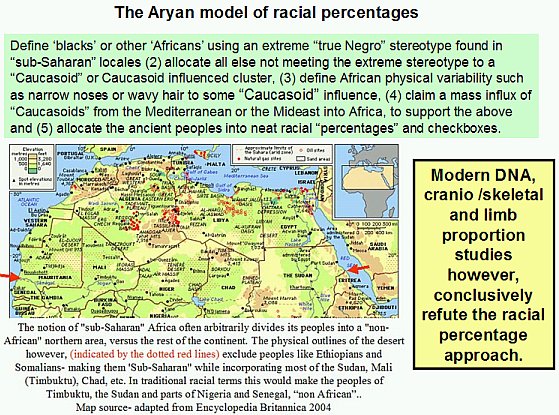
2- Time phases in the peopling of Egypt
From (S. Keita, Further studies of crania from ancient north Africa.)
“The strong Sudanese affinity noted in the unknown analyses may reflect the Nubian interactions with upper Egypt in predynastic times prior to Egyptian unification (Williams, 1980,1986). Ta Seti, the A-Group state based in Qustul (Fig. l), perhaps the earliest known kingdom in the Nile Valley (Williams, 1986), apparently conquered portions of upper Egypt. A-Group type royal tombs have been found in Upper Egypt (Williams, 1986). Later, King Aha (Dynasty I) conquered Ta Seti, incorporating its territory and people into Egypt. Perhaps royal marriages and conquest further homogenized these groups. Ta Seti became the most southern nome of Egypt. On the other hand, early southern “Egyptian” metric phenotypes (Badari, Nakada I) overlap those of Kush/Nubia.
The “European” metrics of some of the crania clearly emphasize the contrasts found in the tombs. This may denote the range of variation encompassed by the coastal northern pattern, given its intermediate position, or reflect the presence of middle easterners. There is no archaeological, linguistic, or historical data which indicate a European or Asiatic invasion of, or migration to, the Nile Valley during First Dynasty times.
Previous concepts about the origin of the First Dynasty Egyptians as being somehow external to the Nile Valley or less “native” are not supported by archeology. In summary, the Abydos First Dynasty royal tomb contents reveal a notable craniometric heterogeneity. Southerners predominate. The suggestion of previous work, namely that crania with southern and coastal northern patterns might be present in these tombs, has been demonstrated and explained by historical and archaeological data.”“Kerma in the Sudan was the center of the early Kush state. These crania date from 2000 to 1800 BC. Collett (1933: 258) notes that: an attempt to divide the whole into two contrasting groups showed that it was quite impossible to distinguish the negroid specimens with any degree of exactness. Hence it was concluded that the safest procedure was to treat the total series as if it represented a single racial type which would obviously be one possessing negroid characters.”
“These crania are easily seen as “Elongated African” (Hiernaux, 1975) or “Nilotic Negro” (Rightmire, 1975a,b), rather than hybrids. The choice of Kerma as the series representative of Nubia is based on the observation that it lay in the middle range of Nubian variation (Mukherjee et al., 1955) and by Crichton’s (1966) views that Nubian series are the most appropriate comparison series of a Negroid people in studies examining Egyptian variation in its African context Ethnic Nubians, called Nehesy by the ancient Egyptians, vary in their phenotype. However, Egyptians, even those with the stereotypically Negroid (Broad) phenotype, were not called Nehesy, reinforcing the idea that Nehesy was an ethno-geographic, not “racial” term (Drake, 1987). The pharaoh who forbade the northern migration of riverine Nubians into Egypt was of an obviously “Negroid dynasty (Yurco, 1989), known to have southern origins.”
"Hiernaux (1975) has accounted for variation in Africa using a nonracial approach; he does not specifically address the northern Nile Valley in great detail, but his concepts, based on micro-evolutionary principles (adaptation, drift, selection), are applicable in this region in the light of recent archaeological data. For example, in living and fossil tropical Africans, narrow faces and noses (versus broad “Negro” ones) do not usually indicate European or Near Eastern migration or “Europoid“ (Caucasian) genes, called Hamitic as once taught, but represent indigenous variation, either connoting a hot-dry climatic adaptation or resulting from drift (Hiernaux, 1975). "
"Hiernaux calls this morphology “Elongated African.” Some of the neolithic Saharans of tropical African affinity (Sutton, 1974; Hiernaux, 1975; after Chamla, 1968) who emigrated to the Nile Valley (Hassan, 1988) might be an example. The view that “elongated” characteristics are indigenous and equally tropical African (“Black) for specific archaeological series and peoples is supported by Gabel (19661, Hiernaux (1975), and Rightmire (1975a,b). The range of variation, “Broad” (stereotypical “Negro”) to Elongated, can be subsumed within a single unit designated Africoid, thereby acknowledging the wider affinities and multiple tropical microadaptive strategies, as well as drift."
"Hiernaux’s perspectives are relevant to the creators of ancient Nile Valley culture, which is an integral part of, and originated in a larger African context (Frankfort, 1950; Childe, 1953; de Heinzelin, 1962; Arkell and Ucko, 1965; Fairman, 1965; Clark, 1970; Shaw, 1976; Vercoutter, 1978; Aldred, 1978; Hassan, 1988), and is not simply a part of, or a corridor to or from the “Mediterranean world”-a cultural construct with limited explanatory power today, as noted by Herzfeld (1984), and almost certainly less in the early Holocene."
“Mediterranean,” connoting a “race,” “one interbreeding population,” at the craniometric level, is questionable as defining the “Middle East” during the Bronze Age (Finkel, 1974,1978), invalid as a term linking geography to a uniform external phenotype (see Snowden, 1970; MacGaffey, 1966; Keita, 1990), inaccurate as a metric taxon for many groups previously assigned to it (Rightmire, 1975a,b), and problematic as a bony craniofacial morphotype denoting a “race” or Mendelian population because of its varied soft-part trait associations and wide geographical distribution (see “Hamitic” in Coon et al., 1950; Gabel, 1966; MacGaffey, 1966; Hiernaux, 1975; Rightmire, 1975a)…"
"Conclusions from cephalometric work imply the presence of southern phenotypes in the north in Old Kingdom times (Harris and Weeks, 1973), which become "“foreign” in a chronological sense by New Kingdom times. "
Aryan race model | Time phases in peopling | Saharan genesis | Sampling bias | Melanin & mummies |
X-rays of the mummies | Egypt Civ based on Upper Sudan | Upper Egypt and Berbers | Skewed methods |
Hiernaux on African diversity | Ancient East Africans | Dark skin and Egypt | Europeans as hybrids
Greeks and blacks
2A- The Saharan genesis of Egyptian civilization
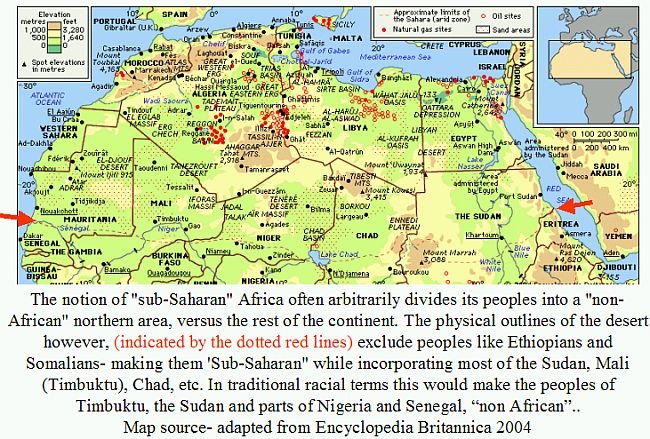
The notion of "sub-Saharan" Africa is
often used in the Aryan model to define African peoples in the
narrowest terms and place them as far south as possible from
Egypt and other northern areas. Everything above this dividing
line can then be classsified as some other race, usually European
or Middle eastern "Caucasoids". Ironically, the peoples
most closely related to the ancient Egyptians- Ethiopians,
Somalians etc are themselves "sub-Saharan" using the
Aryan Model's own arbitrary racial dividing lines. The Saharan
zone furthermore was not always a barren desert, but at one time
extended over one third of Africa and incorporated a variety of
well-watered locales. It is the populations of the Saharan zone,
including the Sudanic belt that would create the Nile Valley
civilizations (See Wendorf et al below) and Saharan peoples would
also contribute to the development of West African cultures and
civilizations in later eras. The main force of the Saharan
genesis lay in the south, in Upper Egypt, not the north of Egypt.
As Vogel (1997) notes in the mainstream Encyclopedia of
Pre-colonial Africa:
"The culture of Upper Egypt, which became dynastic
Egyptian civilization, could fairly be called a Sudanese
transplant".
The Sahara Holocene era saw the first ceramics produced in the Old World- "wavy line" decorated pottery produced in Africa, and Sudanese style impression-decorated pottery is documented as far north as the Egyptian oases and the Great Sand Sea, including the Siwa oasis in Northern Egypt, near the Libyan border. Established populations in this area are also documented during the Pleistocene into the Holocene, as the climate of the Sahara fluctuated in its wet and dry phases. Increasing aridity was to push these indigenous African (Saharan) peoples, who had already domesticated cattle and harvested wild grains, into the Nile Valley, with profound implications for later development of the pharonic civilization. (Rudolph Kruper, et al., Climate-Controlled Holocene Occupation in the Sahara: Motor of Africa's Evolution. Science, Vol 313, 11 Aug 2006, 803-807) This pattern shown by modern non-racial research thus undermines attempts to confine indigenous African peoples somewhere far south. Climate, cranio-skeletal, DNA and other current non-racial research places them throughout the area that would become known as Egypt, with established economies that could easily incorporate new plants and animals from a variety of sources. They did not need to wait aro und for reputed "Caucasoid civilizers" from the Middle East or Europe to appear to usher in the era of the dynasties.
The physical makeup of these peoples were diverse but they were all indigenous Africans. Indeed as Hanihara (1996) shows, early West Asian populations resembled African ones, and limb proportion studies as shown by Zawreski (2003) et. al. show that these early indigenous peoples cluster closer to African types than to European or Middle eastern types. The north of Egypt shows great variation over time, hardly surprising given the genetic diversity of Africans, but even here, the peoples were all indigenous Africans. As respected mainstream Egyptologist, (Kemp 2005) northern populations around sites such as Merimda, Maadi and Wadi Digla have quite different characteristics from sample populations from early Palestine and Byblos:
Aryan race model | Time phases in peopling | Saharan
genesis | Sampling bias | Melanin & mummies | X-rays
of the mummies |
Egypt
civ based on Upper Sudan | Upper Egypt and Berbers | Skewed
methods | Hiernaux on
African diversity |
Ancient East Africans | Dark skin and Egypt | Europeans
as hybrids| Greeks and blacks
3- Sampling bias in DNA studies
"However, in some of the studies, only individuals from northern Egypt are sampled, and this could theoretically give a false impression of Egyptian variability (contrast Lucotte and Mercier 2003a with Manni et al. 2002), because this region has received more foreign settlers (and is nearer the Near East). Possible sample bias should be integrated into the discussion of results. (S.O.Y. Keita, A.J. Boyce, "Interpreting Geographical Patterns of Y Chromosome Variation1," History in Africa 32 (2005) 221-246 )
Materials and methods In 1997, the German Institute for Archaeology headed an excavation of the tombs of the nobles in Thebes-West, Upper Egypt. At this time, three types of tissues were sampled from different mummies: meniscus (fibrocartilage), skin, and placenta. Archaeological findings suggest that the mummies dated from the New Kingdom (approximately 1550_/1080 BC)...... "The basal epithelial cells were packed with melanin as expected for specimens of Negroid origin." - From: "Determination of optimal rehydration, fixation and staining methods for histological and immunohistochemical analysis of mummified soft tissues", Biotechnic & Histochemistry 2005, 80(1): 7_/13
X-ray Atlas of the Royal Mummies (Chicago: University of Chicago, 1980). Courtesy of James Harris and Edward Wente: "In terms of head shape, the XVIV and XX dynasties look more like the early Nubian skulls from the mesolithic with low vaults and sloping, curved foreheads.The XVII and XVIII dynasty skulls are shaped more like modern Nubians with globular skulls and high vaults."
See further details of X-Rays of the Royal mummies here, or here.
6- Early Egyptian civilization an extension of Upper Sudan per mainstream encyclopedia of Pre-Colonial Africa
Quote:
"The period when sub-Saharan Africa was most influential
in Egypt was a time when neither Egypt, as we understand it
culturally, nor the Sahara, as we understand it geographically,
existed. Populations and cultures now found south of the desert
roamed far to the north. The culture of Upper Egypt, which became
dynastic Egyptian civilization, could fairly be called a Sudanese
transplant.(Encyclopedia of Precolonial Africa, by Joseph O.
Vogel, AltaMira Press, Walnut Creek,California (1997), pp.
465-472)
7- Upper Egypt- older research- 1966 and continuity:
Sir Alan Gardiner: These were
long-headed-dolicocephalic is the learned term-and below even
medium stature, but Negroid features are often to be observed.
Whatever may be said of the northerners, it is safe to describe
the dwellers in Upper Egypt as of essentially African stock , a
character always retained despite alien influences brought to
bear on them from time to time." (pg. 392; Egypt of the
Pharaohs 1966)
Alleged Mediterranean invaders sweeping into Sahara
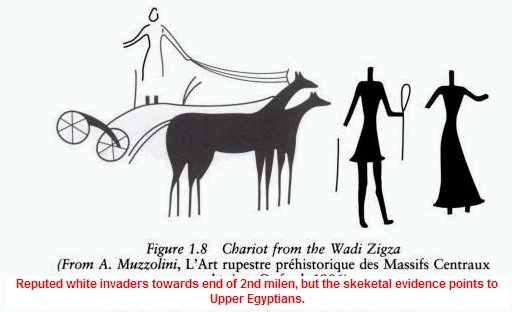
says one book- "The Berbers" Michael Brett, Elizabeth Fentress,
Wiley-Blackwell: 1997
"the original Saharans were 'negroid' and left behind their
distinctive art and iconography in rock carvings and art."
Other writers note that: "Skeletal material associated with an early neolithic site in the Fayum is of 'negroid' type:" --(Henneberg, M, Kobusiewicz, M., Schild,R. and Wendorf, F. 1989. 'The Early Neolithic, Qarunian burial from the Northern Fayum Desert.' In Kryzyaniak, L. and Kobusiewicz, M. (eds.)
Assorted authors claim that said native peoples were overrun
by incoming Caucasoid Mediterraneans who brought horses and
chariots with them, and that around the end of the second
millenium, the Saharan rock art changed from largely pastoral
scenes to show the coming of QUOTE: "elongated white men
with characteristic long hair and pointed beards. Some
confirmation of this racial shift comes from physical
anthropology, although the skeletons seem to show closer
resemblance to groups from the upper Nile Valley than to
contemporary material from the Maghreb."
What is interesting is that the frescoes that supposedly show
this 'white' invasion, are backed up anthropologically by
skeletal material from the Upper Nile Valley, in other words,
Egyptians, not Libyans or alleged Mediterranean Caucasoids. The
Upper Nile Valley is in Southern Egypt closer to Nubia than the
north and the Mediterranean sea. And it is in this area that
Keita et al shows cranio-skeletal material that matches a
tropical African pattern. The limb proportion studies of Zakrewski also confirm Keita's data. Hence those "long
haired" chariot drivers were not "incoming white people" but old Nile Valley African stock.
The Long-hair and pointed beards is interesting because it again
shows the diversity of peoples and styles in Africa. Both Nubians
and Egyptians themselves wore wigs of long hair, and hair was a
trade item, and that beards were no uncommon in Egypt prior to the New Kingdom (Fletcher
1999, 2002). It is thus questionable whether the
chariots or horses are of some "Mediterranean"
invasion, since the backup skeletal evidence noted by the authors
themselves, comes from the "darker" areas of Egypt.
Whether the fresco depicts "invasions" is also
questionable. They could merely represent documentation of
travelers with horses, or persons engaging in trade, or any one
of several different possibilities. There is little parallel
corroborating evidence from other sources of sweeping
'invasions'. Nor do they necessarily represent
"foreigners." They could well be more native Saharan
peoples. In any event the skeletal evidence points to other
indigenous African peoples.
Aryan
race model | Time phases in peopling | Saharan
genesis | Sampling bias | Melanin & mummies | X-rays
of the mummies |
Egypt
civ based on Upper Sudan | Upper Egypt and Berbers | Skewed
methods | Hiernaux on
African diversity |
Ancient East Africans | Dark skin and Egypt | Europeans
as hybrids
Greeks and
blacks
8- Skewed methods in studying African populations
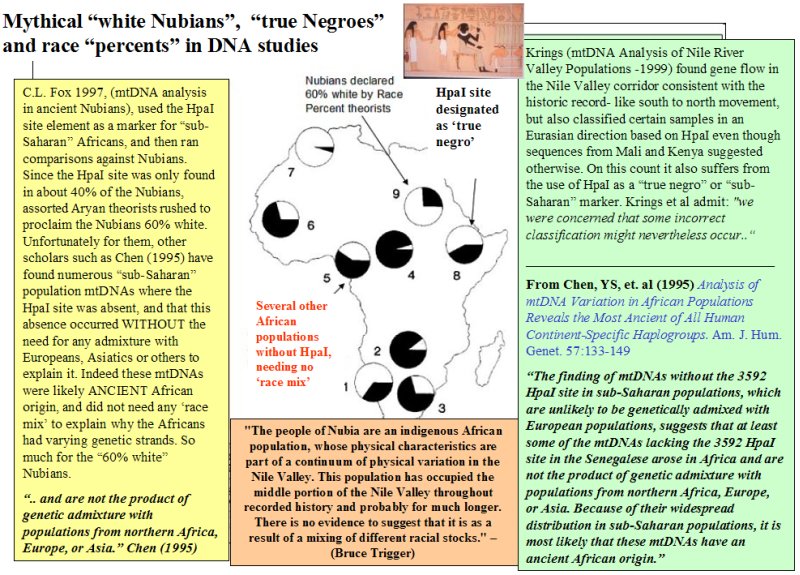
9- The Diversity of African Peoples: Jean Hiernaux "The People of Africa" 1975 p.53-58)
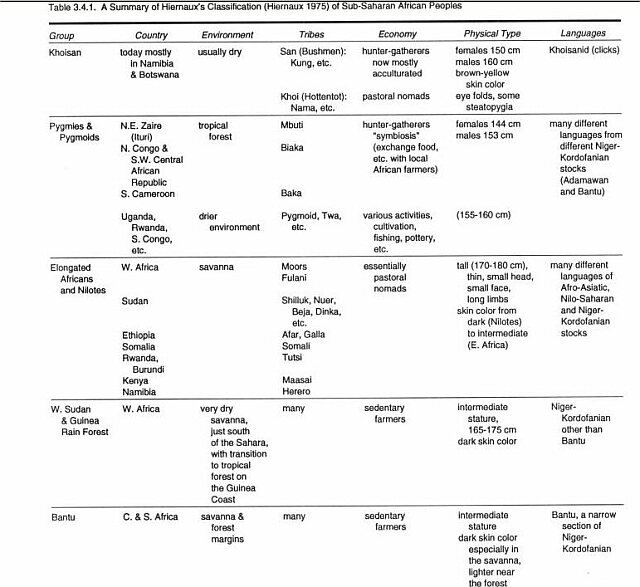
Jean Hiernaux on how diverse Africans look:
Jean Hiernaux, 1975, The People of Africa (Peoples of the World Series)"The oldest remains of Homo sapiens sapiens found in East Africa were associated with an industry having similarities with the Capsian. It has been called Upper Kenyan Capsian, although its derivation from the North African Capsian is far from certain. At Gamble's Cave in Kenya, five human skeletons were associated with a late phase of the industry, Upper Kenya Capsian C, which contains pottery. A similar association is presumed for a skeleton found at Olduvai, which resembles those from Gamble's Cave. The date of Upper Kenya Capsian C is not precisely known (an earlier phase from Prospect Farm on Eburru Mountain close to Gamble's Cave has been dated to about 8000 BC); but the presence of pottery indicates a rather later date, perhaps around 400 BC. The skeletons are of very tall people. They had long, narrow heads, and relatively long, narrow faces. The nose was of medium width; and prognathism, when present, was restricted to the alveolar, or tooth-bearing, region.....
"..all their features can be found in several living populations of East Africa, like the Tutsi of Rwanda and Burundi, who are very dark skinned and differ greatly from Europeans in a number of body proportions............. From the foregoing, it is tempting to locate the area of differentiation of these people in the interior of East Africa. There is every reason to believe that they are ancestral to the living 'Elongated East Africans'. Neither of these populations, fossil and modern, should be considered to be closely related to the populations of Europe and western Asia."
"In sub-Saharan Africa, many anthropological characters show a wide range of population means or frequencies. In some of them, the whole world range is covered in the sub-continent. Here live the shortest and the tallest human populations, the one with the highest and the one with the lowest nose, the one with the thickest and the one with the thinnest lips in the world. In this area, the range of the average nose widths covers 92 per cent of the world range: only a narrow range of extremely low means are absent from the African record. Means for head diameters cover about 80 per cent of the world range; 60 per cent is the corresponding value for a variable once cherished by physical anthropologists, the cephalic index, or ratio of the head width to head length expressed as a percentage....."
Aryan
race model | Time phases in peopling | Saharan
genesis | Sampling bias | Melanin & mummies | X-rays
of the mummies |
Egypt
Civ based on Upper Sudan | Upper Egypt and Berbers | Skewed
methods |
Hiernaux on African diversity | Ancient East Africans
| Dark skin and Egypt | Europeans as hybrids
Greeks and
blacks
9A. C. Loring Brace on the diversity of Africa's peoples and simplistic race percent models
....inhabitants of East Africa right on the equator have appreciably longer, narrower, and higher noses than people in the Congo at the same latitude. A former generation of anthropologists used to explain this paradox by invoking an invasion by an itinerant "white" population from the Mediterranean area, although this solution raised more problems than it solved since the East Africans in question include some of the blackest people in the world with characteristically wooly hair and a body build unique among the world's populations for its extreme linearity and height.............The relatively long noses of East Africa become explicable then when one realizes that much of the area is extremely dry for parts of the year.
(C. Loring Brace, "Nonracial Approach Towards Human Diversity," cited in The Concept of Race, Edited by Ashley Montagu, The Free Press, 1980, pp. 135-136, 138)
10- Who were the ancient East Africans?
Hiernax (1975) above and others noted the diversity of indigenous East African peoples from ancient times, and that such things as narrow noses were part of built-in native variability, and did not indicate that the fundamental stock underwent any "mix" with foreign populations outside Africa. Hiernaux's research is further supported by linguistic and cultural evidence Schepartz (1988) along with skeketal evidence demonstrated by others like Keita (2004). Quote from Schepartz:
Who were the later Pleistocene eastern Africans?
The African Archaeological Review, 6 (1988), pp. 57 72
L . A . SCHEPARTZ
- "Linguistic evidence suggests that, prehistorically, eastern Africa was a place where speakers of at least two other language phyla might have congregated. Ehret's (1974a) reconstruction of proto-Nilotic places Nilo-Saharan-speakers in eastern Africa by at least 4-6000 BP. In keeping with this, Sutton (1974,1977) has suggested that Nilotic language-speakers living in northern Kenya today provide a good analogy for the archaeological remains of semi-permanent lakeshore habitations in the same area dating from between 10,000 and 4000 BP (Owen et al. 1982). Afroasiatic is another language phylum that may have been present early in eastern Africa. Ehret (1974b) suggests Afroasiatic (Southern Cushitic) speakers began moving into eastern Africa at least 5000 years ago and that they may have been responsible for early stone cairn burials in northern Kenya (Stiles and Munro-Hay 1981). Given these linguistic arguments for early populations of Nilo-Saharan and Afroasiatic language-speakers in eastern Africa and their ties with current eastern African populations, it seems more reasonable to regard those groups as the earliest known populations in the region, and to reserve judgement on the role of click language-speakers."
- "If some of the eastern African rock paintings date to the terminal Pleistocene or early Holocene, the tall 'Kolo' peoples may represent groups like the lakeshore fishing folk thought to have been in eastern Africa at least as early as 10,000 BP (Barthelme 1977, 1981; Owen et al. 1982). Human remains from the lakeshore sites of Lothagam, the Lake Turkana Galana Boi beds and Ishango are tall and linear, exactly the features depicted in the 'Kolo' style paintings. This link between the 'Kolo' style paintings and skeletons from the lakeshore sites is supported by other evidence. Archaeologists have proposed that ancestral populations of either Nilo-Saharan (Sutton 1974, 1977) or Afroasiatic language-speakers could have been responsible for these lakeshore sites; and modern speakers of both linguistic phyla are among the tallest and most slender people of eastern Africa (Hiernaux 1968, 1975).
"The role of tall, linearly built populations in eastern Africa's prehistory has always been debated. Traditionally, they are viewed as late migrants into the area. But as there is better palaeoanthropological and linguistic documentation for the earlier presence of these populations than for any other group in eastern Africa, it is far more likely that they are indigenous eastern Africans. I have argued elsewhere (Schepartz 1985) that these prehistoric linear populations show resemblances to both Upper Pleistocene eastern African fossils and present-day, non-Bantu-speaking groups in eastern Africa, with minor differences stemming from changes in overall robusticity of the dentition and skeleton. This suggests a longstanding tradition of linear populations in eastern Africa, contributing to the indigenous development of cultural and biological diversity from the Pleistocene up to the present."
Aryan
race model | Time phases in peopling | Saharan
genesis | Sampling bias | Melanin & mummies | X-rays
of the mummies |
Egypt
Civ based on Upper Sudan | Upper Egypt and Berbers | Skewed
methods |
Hiernaux on African diversity | Ancient East Africans
| Dark skin and Egypt | Europeans as hybrids
Greeks and
blacks
11. Defining or air-brushing dark skin or "blacks" away?
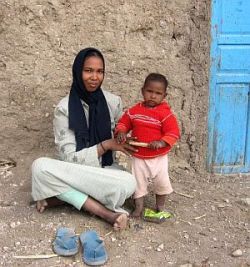
Dark skin is common in Egypt, even today, centuries
after the Arab conquest, as can be seen in the fellahin
or peasant photo above. Dark skin does not and never equalled
"foreign" or "Nubian" in Egypt but is part
and parcel of routine variability from the beginning in the Nile
valley, where amazingly, people vary in how they look. A
dark-brown Egyptian on some tomb paintings might be contrasted
with an even darker Nubian from outside Egypt's borders, but the
contrast is related to point or territory of origin, something
often reinforced by depictions of differences in dress,
hair-styles, etc, not European-style 'race' analysis by the
ancients. The bottom line is that both peoples are still
dark-skinned. Which one of the ancient Egyptian brick makers or
goldsmiths in the tomb painting below for example qualifies as
"truly" black or "non-black"? Who gets
air-brushed away as "non-Egyptian?" And since it was
the 'darker' south that conquered or absorbed the north, does
this make the peoples of Upper Egypt "non-Egyptian"?
Ancient Egyptian goldsmiths.. which
one is "non-black"?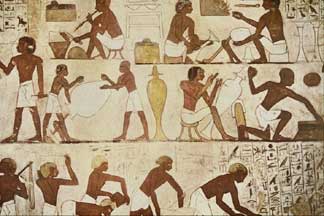
The definition of black and Negro
From Dictionary.com:
Negro- "of, pertaining to, or characteristic of one of the traditional racial divisions of humankind, generally marked by brown to black skin pigmentation.."
From Bartleby.com
"Black - "Of or belonging to a racial
group having brown to black skin, especially one of African origin"
Dark skin has been around from the beginning in Egypt, and is noted as such even in older studies, right down to the present day- contradicting claims and selectively chosen imagery that portrays the bulkof the ancient Egyptians as 'white' of 'light-skinned.' This is clearly demonstrated in the records left by the ancients, and also in scientific studies. Quote:
Newer mainstream research confirms these older analyses, contradicting attempts to airbrush 'darker' peoples out of Egyptian history, or imagery selectively put forward for popular media consumption. Ironically, it was peoples from the 'darker' south that conquered or absorbed the north to establish the Dynastic era of Egypt's civilization. Quote:
"The period when sub-Saharan Africa was most influential in Egypt was a time when neither Egypt, as we understand it culturally, nor the Sahara, as we understand it geographically, existed. Populations and cultures now found south of the desert roamed far to the north. The culture of Upper Egypt, which became dynastic Egyptian civilization, could fairly be called a Sudanese transplant."(Egypt and Sub-Saharan Africa: Their Interaction. Encyclopedia of Precolonial Africa, by Joseph O. Vogel, AltaMira Press, Walnut Creek, California (1997), pp. 465-472 )[119]
Skin color of first homo sapiens (modern humans)
Dark skin evolved with the loss of 'fur' in hominids and is the original state of all homo sapiens. - Jablonski. [2000]
The original human population would have been very dark, similar to, today's equatorial Africans. - Jablonski [2006]
By 1.2 million years ago, all people having descendants today had exactly the receptor protein of today's Africans; their skin was Black, and the intense sun *killed off the progeny with any whiter skin* that resulted from mutational variation in the receptor protein- - (Rogers 2004:107).
Tishkoff on African genetic variability:
"all non-African lineages can be
derived from a single ancestral African haplogroup... non-African
populations [harbour] only a subset of genetic diversity present
in Africa as would be expected.. in the out of Africa
evolutionary model. DNA surveys of 33 globally diverse
populations, found that all non-African populations have a
similar pattern of haplotypic variability and a subset of
variability seen in Ethiopian and Somalian populations,
"which is itself, a subset of the variability that is
present in other sub-Saharan populations." (Tishkoff
SA, Williams SM. "Genetic analysis of African populations.."
"Africa contains tremendous cultural,
linguistic and genetic diversity, and has more than 2,000
distinct ethnic groups and languages.. Studies using
mitochondrial (mt)DNA and nuclear DNA markers consistently
indicate that Africa is the most genetically diverse region of
the world." (Tishkoff
SA, Williams SM., Genetic analysis of African populations: human
evolution and complex disease. Nature Reviews Genetics. 2002 Aug
(8):611-21.)
Aryan
race model | Time phases in peopling | Saharan
genesis | Sampling bias | Melanin & mummies | X-rays
of the mummies |
Egypt
Civ based on Upper Sudan | Upper Egypt and Berbers | Skewed
methods |
Hiernaux on African diversity | Ancient East Africans
| Dark skin and Egypt | Europeans as hybrids
Greeks and
blacks
13. Greeks more related to blacks than other Mediterraneans, according to 3 recent DNA studies
Study #1
HLA genes in Macedonians and the
sub-Saharan origin of the Greeks
A. Arnaiz-Villena, K. Dimitroski, A. Pacho, J.
Moscoso, E. Gómez-Casado, et. al
Tissue Antigens (2001) Volume 57, Issue 2 ,
Pages118 - 127
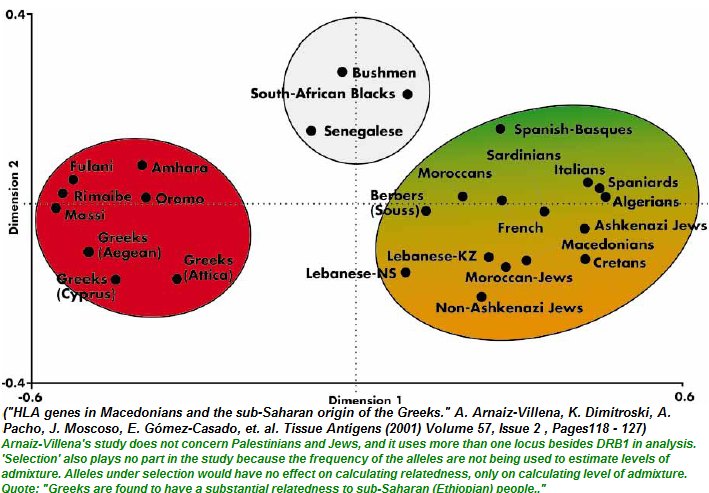
sub-Saharan affinities of the Greeks
From abstract:
"1) Macedonians belong to the "older"
Mediterranean substratum, like Iberians (including Basques),
North Africans, Italians, French, Cretans, Jews, Lebanese, Turks
(Anatolians), Armenians and Iranians, 2) Macedonians are not
related with geographically close Greeks, who do not belong to
the "older" Mediterranenan substratum, 3) Greeks are
found to have a substantial relatedness to sub-Saharan
(Ethiopian) people, which separate them from other Mediterranean
groups. Both Greeks and Ethiopians share quasi-specific DRB1
alleles.. Genetic distances are closer between Greeks and
Ethiopian/sub-Saharan groups than to any other Mediterranean
group and finally Greeks cluster with Ethiopians/sub-Saharans in
both neighbour joining dendrograms and correspondence analyses.
The time period when these relationships might have occurred was
ancient but uncertain and might be related to the displacement of
Egyptian-Ethiopian people living in pharaonic Egypt."
Study #2
From:
"Population
genetic relationships between Mediterranean populations determined by HLA allele
distribution--a historic perspective."
A. Arnaiz-Villena , E. Gomez-Casado,
J. Martinez-Laso.
Tissue Antigens, Volume 60, Number
2, August 2002, pp 111-121(11)
QUOTES:
 "HLA
genomics shows that: 1) Greeks share an important part of their genetic pool
with sub-Saharan Africans (Ethiopians and West Africans) also supported by Chr 7
Markers. The gene flow from Black Africa to
"HLA
genomics shows that: 1) Greeks share an important part of their genetic pool
with sub-Saharan Africans (Ethiopians and West Africans) also supported by Chr 7
Markers. The gene flow from Black Africa to
"Other Negroid genes have also been found in Greeks. They are the only Caucasoid population who bears cystic fibrosis mutations typical of Black Africans (Chromosome 7). See Dork, et al. In Am. J. Hum. Genet, 1998: 63: 656-682."
"A more likely explanation is that some time during Egyptian pharaonic times a Black dynasty with their followers were expelled and went towards
Study #3
"HLA genes in
Southern Tunisians (Ghannouch area) and their relationship with other
Mediterraneans."
European Journal Medical Genetics. 2006 Jan-Feb;49(1):43-56.
A, Hmida S, Kaabi H, Dridi A, Jridi A, El Gaa l ed A, Boukef K.
QUOTES:
"South Tunisian HLA gene profile has studied for the first time. HLA-A, -B, -DRB1 and -DQB1 allele frequencies of Ghannouch have been compared with those of neighboring populations, other Mediterraneans and Sub-Saharans. Their relatedness has been tested by genetic distances, Neighbor-Joining dendrograms and correspondence analyses. Our HLA data show that both southern from Ghannouch and northern Tunisians are of a Berber substratum in spite of the successive incursions (particularly, the 7th-8th century A.D. Arab invasion) occurred in Tunisia. It is also the case of other North Africans and Iberians. This present study confirms the relatedness of Greeks to Sub-Saharan populations. This suggests that there was an admixture between the Greeks and Sub-Saharans probably during Pharaonic period or after natural catastrophes (dryness) occurred in Sahara."
14. Ancient Egyptians (circa 2687-2191 BC) more related to Black Americans than Whites
"We also compare Egyptian body proportions
to those of modern American Blacks and Whites... Long bone
stature regression equations were then derived for each sex. Our
results confirm that, although ancient Egyptians are closer in
body proportion to modern American Blacks than they are to
American Whites, proportions in Blacks and Egyptians are not
identical... Intralimb indices are not significantly different
between Egyptians and American Blacks."
("Stature estimation in ancient Egyptians: A new
technique based on anatomical reconstruction of stature."
Michelle H. Raxter, Christopher B. Ruff, Ayman Azab, Moushira
Erfan, Muhammad Soliman, Aly El-Sawaf, (Am J Phys Anthropol.
2008, Jun;136(2):147-55)

Recent study finds the ancient Egyptians had a
tropical body plan like sub-Saharan 'black' Africans and were not
cold-adapted like European type populations
QUOTE:
"The raw values in Table 6 suggest
that Egyptians had the “super-Negroid” body plan
described by Robins (1983).. This pattern is supported by Figure
7 (a plot of population mean femoral and tibial lengths; data
from Ruff, 1994), which indicates that the Egyptians generally
have tropical body plans. Of the Egyptian samples, only the
Badarian and Early Dynastic period populations have shorter
tibiae than predicted from femoral length. Despite these
differences, all samples lie relatively clustered together as
compared to the other populations." (Zakrzewski,
S.R. (2003). "Variation in ancient Egyptian stature and body
proportions". American Journal of Physical Anthropology 121
(3): 219-229.
Modern DNA studies find even though some African peoples
look different, they are genetically related through the PN2
transition clade of the Y-chromosone. Thus light skinned Libyans
and dark-skinned Zulus are all genetically related Africans even
though they don't look exactly the same.
"But the Y-chromosome clade defined by
the PN2 transition (PN2/M35, PN2/M2) shatters the boundaries of
phenotypically defined races and true breeding populations across
a great geographical expanse. African peoples with a range of
skin colors, hair forms and physiognomies have substantial
percentages of males whose Y chromosomes form closely related
clades with each other, but not with others who are
phenotypically similar. The individuals in the morphologically or
geographically defined 'races' are not characterized by 'private'
distinct lineages restricted to each of them." (S
O Y Keita, R A Kittles, et al. "Conceptualizing human
variation," Nature Genetics 36, S17 - S20 (2004)
Northern Egypt shows more physical variation than the
south, but were closer to southerners than any other peoples. In
comparisons with "Middle Eastern" populations of the
same ancient period, the Egyptians link more closely with other
Africans than the Middle Easterners.
QUOTE(s):
"..sample populations available from
northern Egypt from before the 1st Dynasty (Merimda, Maadi and
Wadi Digla) turn out to be significantly different from sample
populations from early Palestine and Byblos, suggesting a lack of
common ancestors over a long time. If there was a south-north
cline variation along the Nile valley it did not, from this
limited evidence, continue smoothly on into southern Palestine.
The limb-length proportions of males from the Egyptian sites
group them with Africans rather than with Europeans."
(Barry Kemp, "Ancient Egypt Anatomy of a Civilisation.
(2005) Routledge. p. 52-60)
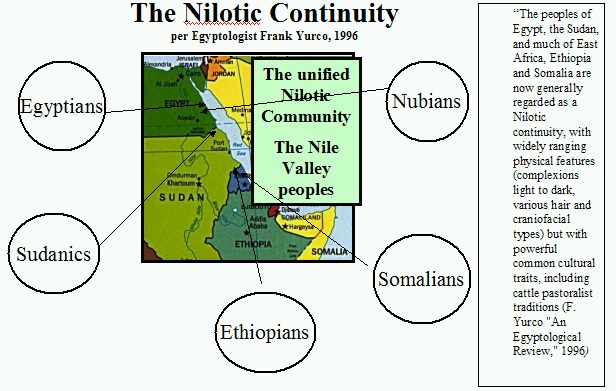 The jump-starters and creators of the Dynasties
originated in the south closer to Nubia, the Sudan and Ethiopia
than in the north with its Mediterranean and Middle Eastern
neighbors.
The jump-starters and creators of the Dynasties
originated in the south closer to Nubia, the Sudan and Ethiopia
than in the north with its Mediterranean and Middle Eastern
neighbors.
QUOTE(s):
S. O. Y. Keita, "Studies and Comments on
Ancient Egyptian Biological Relationships," History in
Africa 20 (1993) 129-54
"Overall, when the Egyptian crania are
evaluated in a Near Eastern (Lachish) versus African (Kerma,
Kebel Moya, Ashanti) context) the affinity is with the Africans.
The Sudan and Palestine are the most appropriate comparative
regions which would have 'donated' people, along with the Sahara
and Maghreb. Archaeology validates looking to these regions for
population flow (see Hassan 1988)... Egyptian groups showed less
overall affinity to Palestinian and Byzantine remains than to
other African series, especially Sudanese." (Keita 1993)
"When the unlikely relationships [Indian matches] and
eliminated, the Egyptian series are more similar ''overall'' to
other African series than to European or Near Eastern (Byzantine
or Palestinian) series." (Keita 1993)
"Populations and cultures now found south of the desert
roamed far to the north. The culture of Upper Egypt, which became
dynastic Egyptian civilization, could fairly be called a Sudanese
transplant."(Egypt and Sub-Saharan Africa: Their
Interaction. Encyclopedia of Precolonial Africa, by Joseph O.
Vogel, AltaMira Press, Walnut Creek, California (1997), pp.
465-472 )
"Analysis of crania is the traditional approach to assessing
ancient population origins, relationships, and diversity. In
studies based on anatomical traits and measurements of crania,
similarities have been found between Nile Valley crania from
30,000, 20,000 and 12,000 years ago and various African remains
from more recent times (see Thoma 1984; Brauer and Rimbach 1990;
Angel and Kelley 1986; Keita 1993). Studies of crania from
southern predynastic Egypt, from the formative period (4000-3100
B.C.), show them usually to be more similar to the crania of
ancient Nubians, Kushites, Saharans, or modern groups from the
Horn of Africa than to those of dynastic northern Egyptians or
ancient or modern southern Europeans."
(S. O. Y and A.J.
Boyce, "The Geographical Origins and Population
Relationships of Early Ancient Egyptians", in in Egypt in
Africa, Theodore Celenko (ed), Indiana University Press, 1996,
pp. 20-33)
Different features like narrow noses are not due to
different "race" mixes but are part of the built-in
physical diversity and variation of African peoples. Narrow noses
appear in the oldest African populations for example, in Kenya's
Gamble Cave complex. They do not need any outside race mix to
make them the way they are.
QUOTE(s):
".. all their features can be
found in several living populations of East Africa, like the
Tutsi of Rwanda and Burundi, who are very dark skinned and differ
greatly from Europeans in a number of body proportions.. There is
every reason to believe that they are ancestral to the living
'Elongated East Africans'. Neither of these populations, fossil
and modern, should be considered to be closely related to the
populations of Europe and western Asia..." [Jean
Hiernaux, The People of Africa (1975), pgs 42-43, 62-63)
Recent study shows ancient Egyptians physically more
like Black Americans than White Americans
QUOTE(s):
"We also compare Egyptian body
proportions to those of modern American Blacks and Whites... Long
bone stature regression equations were then derived for each sex.
Our results confirm that, although ancient Egyptians are closer
in body proportion to modern American Blacks than they are to
American Whites, proportions in Blacks and Egyptians are not
identical... Intralimb indices are not significantly different
between Egyptians and American Blacks." ("Stature
estimation in ancient Egyptians: A new technique based on
anatomical reconstruction of stature." Michelle H. Raxter,
Christopher B. Ruff, Ayman Azab, Moushira Erfan, Muhammad
Soliman, Aly El-Sawaf, (Am J Phys Anthropol. 2008,
Jun;136(2):147-55
Africa is the most genetically diverse region in the
world with the original man being from East Africa according to
conservative scholars:
"Africa contains tremendous cultural,
linguistic and genetic diversity, and has more than 2,000
distinct ethnic groups and languages.. Studies using
mitochondrial (mt)DNA and nuclear DNA markers consistently
indicate that Africa is the most genetically diverse region of
the world." (Tishkoff SA, Williams SM., Genetic
analysis of African populations: human evolution and complex
disease. Nature Reviews Genetics. 2002 Aug (8):611-21.)
" In other words, all non-Africans
carry M168. Of course, Africans carrying the M168 mutation today
are the descendants of the African subpopulation from which the
migrants originated.... Thus, the Australian/Eurasian Adam (the
ancestor of all non-Africans) was an East African Man."
(Linda Stone, Paul F. Lurquin, L. Luca Cavalli-Sforza, Genes,
Culture, and Human Evolution: A Synthesis, Wiley-Blackwell: 2006,
pg 108)
Sampling bias in some Nile Valley research hinders a full
understanding of the region's complexity, although more accurate
approaches give a broader picture.
QUOTE(s):
"However, in some of the studies,
only individuals from northern Egypt are sampled, and this could
theoretically give a false impression of Egyptian variability
(contrast Lucotte and Mercier 2003a with Manni et al. 2002),
because this region has received more foreign settlers (and is
nearer the Near East). Possible sample bias should be integrated
into the discussion of results." (S.O.Y.
Keita, A.J. Boyce, "Interpreting Geographical Patterns of Y
Chromosome Variation1," History in Africa 32 (2005) 221-246
)
Ancient Egyptian civilization was indigenous with continuity among its peoples, not an influx of Middle Easterners, Europeans or other outsiders like Arabs until relatively late in history
QUOTE(s):
"Some have argued that various early
Egyptians like the Badarians probably migrated northward from
Nubia, while others see a wide-ranging movement of peoples across
the breadth of the Sahara before the onset of desiccation.
Whatever may be the origins of any particular people or
civilization, however, it seems reasonably certain that the
predynastic communities of the Nile valley were essentially
indigenous in culture, drawing little inspiration from sources
outside the continent during the several centuries directly
preceding the onset of historical times..." (Robert
July, Pre-Colonial Africa, 1975, p. 60-61)
"overall population continuity over
the Predynastic and early Dynastic, and high levels of genetic
heterogeneity, thereby suggesting that state formation occurred
as a mainly indigenous process."
(Zakrzewski, S.R. (2007). "Population continuity or
population change: Formation of the ancient Egyptian state".
American Journal of Physical Anthropology 132 (4): 501-509)
"the peoples of the steppes and
grasslands to the immediate south of Egypt domesticated cattle,
as early as 9000 to 8000 B.C. They included peoples from the
Afro-Asiastic linguistic group and the second major African
language family, Nilo-Saharan (Wendorf, Schild, Close 1984;
Wendorf, et al. 1982). Thus the earliest domestic cattle may have
come to Egypt from these southern neighbors, circa 6000 B.C., and
not from the Middle East.[148] Pottery, another significant
advance in material cultural may also have followed this pattern,
initiatied "as early as 9000 B.C. by the Nilo-Saharans and
Afrasians who lived to the south of Egypt. Soon thereafter, pots
spread to Egyptian sites, almost 2,000 years before the first
pottery was made in the Middle East."
(Christopher Ehret, "Ancient Egyptian as an African
Language, Egypt as an African Culture," in Egypt in Africa,
Theodore Celenko (ed), Indiana University Press, 1996, pp. 25-27)
Ancient Egyptian religion closer to the religion of African
regions than to Mesopotamia, Europe or the Middle East
QUOTE(s):
Encyclopedia Britannica 1984 ed. Macropedia Article, Vol 6:
"Egyptian Religion" , pg 506-508
"A large number of gods go back to
prehistoric times. The images of a cow and star goddess (Hathor),
the falcon (Horus), and the human-shaped figures of the fertility
god (Min) can be traced back to that period. Some rites, such as
the "running of the Apil-bull," the "hoeing of the
ground," and other fertility and hunting rites (e.g., the
hippopotamus hunt) presumably date from early times.. Connections
with the religions in southwest Asia cannot be traced with
certainty."
"It is doubtful whether Osiris can be regarded as equal to
Tammuz or Adonis, or whether Hathor is related to the "Great
Mother." There are closer relations with northeast African
religions. The numerous animal cults (especially bovine cults and
panther gods) and details of ritual dresses (animal tails, masks,
grass aprons, etc) probably are of African origin. The kinship in
particular shows some African elements, such as the king as the
head ritualist (i.e., medicine man), the limitations and renewal
of the reign (jubilees, regicide), and the position of the king's
mother (a matriarchal element). Some of them can be found among
the Ethiopians in Napata and Meroe, others among the Prenilotic
tribes (Shilluk)."
(Encyclopedia Britannica 1984 ed. Macropedia Article, Vol 6:
"Egyptian Religion" , pg 506-508)
Egyptian civilization based from the 'darker' south
(Upper Egypt) not the north (Lower Egypt)
QUOTE(s):
"While not attempting to underestimate
the contribution that Deltaic political and religious
institutions made to those of a united Egypt, many Egyptologists
now discount the idea that a united prehistoric kingdom of Lower
Egypt ever existed."
"While communities such as Ma'adi appear to have played an
important role in entrepots through which goods and ideas form
south-west Asia filtered into the Nile Valley in later
prehistoric times, the main cultural and political tradition that
gave rise to the cultural pattern of Early Dynastic Egypt is to
be found not in the north but in the south.":
The Cambridge History of Africa: Volume 1, From the Earliest
Times to c. 500 BC, (Cambridge University Press: 1982), Edited by
J. Desmond Clark pp. 500-509
"..the early cultures of Merimde, the
Fayum, Badari Naqada I and II are essentially African and early
African social customs and religious beliefs were the root and
foundation of the ancient Egyptian way of life." (Source:
Shaw, Thurston (1976) Changes in AfricanArchaeology in the Last
Forty Years in African Studies since 1945. p. 156-68. London.)
Much older scholarship shows cultural similarities
between ancient Egypt and the rest of Africa, contradicting
claims of Middle Eastern inspiration.
Specific central African tool designs found at the well known
Naqada, Badari and Fayum archaeological sites in Egypt (de
Heinzelin 1962, Arkell and Ucko, 1956 et al). Shaw (1976) states
that "the early cultures of Merimde, the Fayum, Badari
Naqada I and II are essentially African and early African social
customs and religious beliefs were the root and foundation of the
ancient Egyptian way of life."
Pottery evidence first seen in the Saharan Highlands then
spreading to the Nile Valley (Flight 1973).
Art motifs of Saharan rock paintings showing similarities to
those in pharaonic art. A number of scholars suggest that these
earlier artistic styles influenced later pharaonic art via
Saharans leaving drier areas and moving into the Nile Valley
taking their art styles with them (Mori 1964, Blanc 1964, et al)
Earlier pioneering mummification outside Egypt. The oldest mummy in Africa is of a black Saharan child (Donadoni 1964, Blanc 1964) Frankfort (1956) suggests that it is thus possible to understand the pharaonic worldview by reference to the religious beliefs of these earlier African precursors. Attempts to suggest the root of such practices are due to Caucasoid civilizers from elsewhere are thus contradicted by the data on the ground.
Several cultural practices of Egypt show strong similarities to an African totemic clan base. Childe (1969, 1978), Aldred (1978) and Strouhal (1971) demonstrate linkages with several African practices such as divine kingship and the king as divine rainmaker.
Physical similarities of the early Nile valley populations with that of tropical Africans. Such connections are demonstrated in the work of numerous scholars such as Thompson and Randall Mclver 1905, Falkenburger 1947, and Strouhal 1971. The distance diagrams of Mukherjee, Rao and Trevor (1955) place the ancient Badarians genetically near 'black' tribes such as the Ashanti and the Taita. See also the "Issues of lumping under Mediterranean clusters" section above for similar older analyses.
Serological (blood) evidence of genetic linkages. Paoli 1972 for example found a significant resemblance between ABO frequencies of dynastic Egyptians and the black northern Haratin who are held to be the probable descendants of the original Saharans (Hiernaux, 1975).
Language similarities which include several hundred roots ascribable to African elements (UNESCO 1974)
Ancient Egyptian origin stories ascribing origins of the gods and their ancestors to African locations to the south and west of Egypt (Davidson 1959)
Advanced state building and political unity in Nubia, including writing, administrative apparatus and insignia some 300 years before dynastic Egypt, and the long demonstrated interchange between Nubia and Egypt (Williams 1980)
Newer studies (Wendorf 2001, Wilkinson 1999, et al.) confirm these older analyses. Excavations from Nabta Playa, located about 100km west of Abu Simbel for example, suggest that the Neolithic inhabitants of the region were migrants from Sub-Saharan Africa, based on cultural similarities and social complexity which is thought to be reflective of Egypt's Old Kingdom
Other scholars (Wilkinson 1999) present similar material and
cultural evidence- including similarities between predynastic
Egypt and traditional African cattle-culture, typical of Southern
Sudanese and East African pastoralists of today, and various
cultural and artistic data such as iconography on rock art found
in both Egypt and in the Sudan.
The Sahara and the Sudan seem to have provided a major
source for the genesis of Egyptian civilization contributing many
of its unique elements.
QUOTE(s):
"a critical factor in the rise of
social complexity and the subsequent emergence of the Egyptian
state in Upper Egypt (Hoffman 1979; Hassan 1988). If so, Egypt
owes a major debt to those early pastoral groups in the Sahara;
they may have provided Egypt with many of those features that
still distinguish it from its neighbors to the east."
Journal of Anthropological Archaeology 17, 97-123 (1998),
"Nabta Playa and Its Role in Northeastern African
Prehistory," Fred Wendorf and Romuald Schild.
"Over the last two decades,
numerous contemporary (Khartoum Neolithic) sites and cemeteries
have been excavated in the Central Sudan.. The most striking
point to emerge is the overall similarity of early neolithic
developments inhabitation, exchange, material culture and
mortuary customs in the Khartoum region to those underway at the
same time in the Egyptian Nile Valley, far to the north." (Wengrow,
David (2003) "Landscapes of Knowledge, Idioms of Power: The
African Foundations of Ancient Egyptian Civilization
Reconsidered," in Ancient Egypt in Africa, David O'Connor
and Andrew Reid, eds. Ancient Egypt in Africa. London: University
College London Press, 2003, pp. 119-137)
Ancient Egyptian language is part of the Afrasan or
Afro-Asiatic group which has its origins in Africa, and together
with other archaeological evidence firmly makes it an African
culture.
QUOTE(s):
"Ancient Egyptian civilization was, in
ways and to an extent usually not recognized, fundamentally
African. The evidence of both language and culture reveals these
African roots. The origins of Egyptian ethnicity lay in the areas
south of Egypt. The ancient Egyptian language belonged to the
Afrasian family (also called Afroasiatic or, formerly,
Hamito-Semitic). The speakers of the earliest Afrasian languages,
according to recent studies, were a set of peoples whose lands
between 15,000 and 13,000 B.C. stretched from Nubia in the west
to far northern Somalia in the east. "
(Christopher Ehret (1996) "Ancient Egyptian as an
African Language, Egypt as an African Culture." In Egypt in
Africa Egypt in Africa, Theodore Celenko (ed), Indiana University
Press)
"Ancient Egypt belongs to a language
group known as 'Afro-Asiatic' (formerly called Hamito-Semitic)
and its closest relatives are other north-east African languages
from Somalia to Chad. Egypt's cultural features, both material
and ideological and particularly in the earliest phases, show
clear connections with that same broad area. In sum, ancient
Egypt was an African culture, developed by African peoples, who
had wide ranging contacts in north Africa and western Asia."
(Morkot, Robert (2005) The Egyptians: An Introduction.
Routledge. p. 10)
Egyptian Y-chromosome haplotypes show preponderance is with African clusters not Europe or the Near East
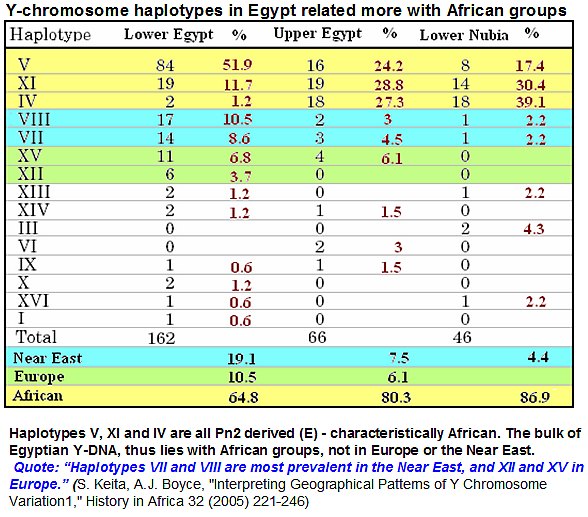
Haplotype map
|
Haplotype E - the African origin Haplotype is in green. Dispersions and heaviest concentrations in Africa, to parts of Europe and the Middle East- part of the (OOA) Out of Africa migrations.
E1b1a --- SRV10831.1, M42, M94, M139, M168, P9, M145, M213, Yap, SRY4064, M96, P29, P2, DYS391p, M2, P1 |
Ethiopians and Somalis group with other Africans rather than Europeans or
"Middle easterners"

Aryan
race model | Time phases in peopling | Saharan
genesis | Sampling bias | Melanin & mummies | X-rays
of the mummies | Egypt Civ based on
Upper Sudan | Upper Egypt and Berbers | Skewed
methods | Hiernaux on
African diversity |
Ancient East Africans | Dark skin and Egypt | Europeans
as hybrids| Greeks and blacks | Black
Americans | Quotes
Quotations
Home | Quotations | Misc Notes | Notes 2 | Hair | DemicDiff | Diversity | AsianIQ
Egypt in Africa
| Black-Greek-DNA links
| misc3 | Misc
notes 4| Misc
news clips
|
Link to research papers and articles: (wysinger.homestead.com/keita.html) |
|
Link to current African DNA research: (http://exploring-africa.blogspot.com/) |
|
Google Search- other data |